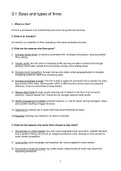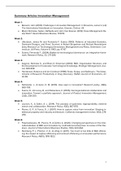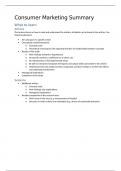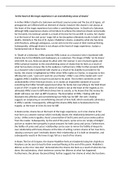3.1 Sizes and types of firms
1. What is a firm?
A firm is a production unit, transforming resources into goods and services.
2. What is an industry?
An industry is a collection of firms operating in the same production process.
3. What are the reasons why firms grow?
i) Increase market share: to become a dominant firm. Increases monopsony, revenue position.
Price setting
ii) Greater profits: the firm aims to maximise profits and may be able to achieve this through
growing: more sales, benefit from economies of scale, price setting power
iii) Increase brand recognition: through having more sales outlets geographically for example,
increasing customer reach thus increasing sales.
iv) Increase economies of scale: The firm is able to exploit its increased size to spread out costs
thus driving LRAC down. Moving down LRAC to MES the firm moves closer to productive
efficiency. (more on economies of scale below)
v) Reduce Risk Profile through growth reducing risk of default in the face of an economic
downturn. Reduce takeoff risk. Overall aim for stronger balance sheet profile.
vi) Satisfy management’s ambition personal reasons: i.e. lust for power driving managers, share
price growth resulting in bigger bonuses.
vii) Opportunism making use of spare cash that would otherwise be taxed
viii) Expertise entering new markets in an effort to diversify
4. What are the reasons why some firms choose to stay small?
i) Concentrate on niche markets: top- end, luxury segments have more price- inelastic demand,
thus a greater markup can be put on marginal production costs. Staying in niche avoids the
mass market competition.
ii) Local profile: local knowledge and expertise can only be applied in local markets.
iii) Economies of scale are limited: eg. coffee shops, diseconomies of scale may result from
expanding production
1
,iv) Business objectives: some firms do not aim to profit maximise, they want to stay connected to
customers, business may also be a hobby.
v) Tax advantages: smaller firms have to pay less tax in some instances.
vi) Avoiding the p/a problem.
5. Outline the principal- agent problem
- Divorce of ownership from control occurs when the day to day running of the business is
delegated to management in cases where there is a large number of shareholders.
- The principal is the shareholder of the company
- The agent is the person in charge of day to day operations of the business
- A conflict between the principal and the agent may occur when the agent makes decisions not
fully reflecting the principal’s ambitions OR
- As a result of asymmetric information, the principal is not fully aware of the agent’s actions
- May result in the agent being dismissed
6. What is the difference between the private and public sectors?
- PRIVATE SECTOR: private sector firms are not owned by the gvt. They may be PLCs (shares
traded) or family- owned. Sole proprietors also constitute the private sector. AIM: make $
- PUBLIC SECTOR: The gvt. owned businesses such as NHS, Network rail. Operate from
taxpayers funding, does not make profit for shareholders, but instead reinvests any surplus
funds.
7. What is are non- for profit enterprises.
- Charities/ civil societies, existing to provide services to local, national and international
communities, without profit as their main primary goal.
3.2 Business Growth
1. Define organic growth:
- Organic growth is when a firm expands the scale of its operation and gains market share by
investment within the firm done by the firm from profits or debt.
2. Define Horizontal integration:
- Where there is a merger between two firms at the same stage of production. Often chosen to
achieve economies of scale or increase market share.
2
, 3. Define and describe both types of Vertical Integration:
VERTICAL INTEGRATION: is a merger between two firms at different stages of productive process
within an industry. Often chosen to increase barriers to entry, increase supplier control, or smooth
out the production process.
FORWARD VERTICAL: When a firm at the next production stage closer to customer is bought.
BACKWARD VERTICAL: When a firm at the previous production stage is bought.
4. Define conglomerate integration:
Where there is a merger between firms in entirely unrelated industries. Often chosen to spread
risk, widen output to reduce exposure to one market. Allows cross- subsidisation without losing
revenue drivers.
5. What are the benefits and drawbacks of each type of merger?
Type Definition Example
Horizontal A merger between two firms in the ASDA/ SAINSBURYS
same industry and the same
stage of production merge with FOX/DISNEY
each other.
Orange/ T- Mobile
Backward Vertical Backward integration: a a car manufacturer buying a tyre
purchaser buying one of its manufacturer
suppliers
Forward Vertical Forward integration: a supplier A car manufacturer buying a car
merging with one of its buyers dealership
Conglomerate The merging of two firms with no Tobacco manufacturer buying an
common interest insurance company
Type Advantages Disadvantages
Organic - Really low risk - Slower than slap- on
acquisitions for example.
- Less initial funding
Horizontal - Increases market power - Unwanted regulatory attention
- Reduces competition - Likely leads to job losses, thus
harms staff morale
- increases price setting power
Vertical - Reducing cots - There might be an instance
where a company may set the
- Insures access to the needed price higher
supplies
3
1. What is a firm?
A firm is a production unit, transforming resources into goods and services.
2. What is an industry?
An industry is a collection of firms operating in the same production process.
3. What are the reasons why firms grow?
i) Increase market share: to become a dominant firm. Increases monopsony, revenue position.
Price setting
ii) Greater profits: the firm aims to maximise profits and may be able to achieve this through
growing: more sales, benefit from economies of scale, price setting power
iii) Increase brand recognition: through having more sales outlets geographically for example,
increasing customer reach thus increasing sales.
iv) Increase economies of scale: The firm is able to exploit its increased size to spread out costs
thus driving LRAC down. Moving down LRAC to MES the firm moves closer to productive
efficiency. (more on economies of scale below)
v) Reduce Risk Profile through growth reducing risk of default in the face of an economic
downturn. Reduce takeoff risk. Overall aim for stronger balance sheet profile.
vi) Satisfy management’s ambition personal reasons: i.e. lust for power driving managers, share
price growth resulting in bigger bonuses.
vii) Opportunism making use of spare cash that would otherwise be taxed
viii) Expertise entering new markets in an effort to diversify
4. What are the reasons why some firms choose to stay small?
i) Concentrate on niche markets: top- end, luxury segments have more price- inelastic demand,
thus a greater markup can be put on marginal production costs. Staying in niche avoids the
mass market competition.
ii) Local profile: local knowledge and expertise can only be applied in local markets.
iii) Economies of scale are limited: eg. coffee shops, diseconomies of scale may result from
expanding production
1
,iv) Business objectives: some firms do not aim to profit maximise, they want to stay connected to
customers, business may also be a hobby.
v) Tax advantages: smaller firms have to pay less tax in some instances.
vi) Avoiding the p/a problem.
5. Outline the principal- agent problem
- Divorce of ownership from control occurs when the day to day running of the business is
delegated to management in cases where there is a large number of shareholders.
- The principal is the shareholder of the company
- The agent is the person in charge of day to day operations of the business
- A conflict between the principal and the agent may occur when the agent makes decisions not
fully reflecting the principal’s ambitions OR
- As a result of asymmetric information, the principal is not fully aware of the agent’s actions
- May result in the agent being dismissed
6. What is the difference between the private and public sectors?
- PRIVATE SECTOR: private sector firms are not owned by the gvt. They may be PLCs (shares
traded) or family- owned. Sole proprietors also constitute the private sector. AIM: make $
- PUBLIC SECTOR: The gvt. owned businesses such as NHS, Network rail. Operate from
taxpayers funding, does not make profit for shareholders, but instead reinvests any surplus
funds.
7. What is are non- for profit enterprises.
- Charities/ civil societies, existing to provide services to local, national and international
communities, without profit as their main primary goal.
3.2 Business Growth
1. Define organic growth:
- Organic growth is when a firm expands the scale of its operation and gains market share by
investment within the firm done by the firm from profits or debt.
2. Define Horizontal integration:
- Where there is a merger between two firms at the same stage of production. Often chosen to
achieve economies of scale or increase market share.
2
, 3. Define and describe both types of Vertical Integration:
VERTICAL INTEGRATION: is a merger between two firms at different stages of productive process
within an industry. Often chosen to increase barriers to entry, increase supplier control, or smooth
out the production process.
FORWARD VERTICAL: When a firm at the next production stage closer to customer is bought.
BACKWARD VERTICAL: When a firm at the previous production stage is bought.
4. Define conglomerate integration:
Where there is a merger between firms in entirely unrelated industries. Often chosen to spread
risk, widen output to reduce exposure to one market. Allows cross- subsidisation without losing
revenue drivers.
5. What are the benefits and drawbacks of each type of merger?
Type Definition Example
Horizontal A merger between two firms in the ASDA/ SAINSBURYS
same industry and the same
stage of production merge with FOX/DISNEY
each other.
Orange/ T- Mobile
Backward Vertical Backward integration: a a car manufacturer buying a tyre
purchaser buying one of its manufacturer
suppliers
Forward Vertical Forward integration: a supplier A car manufacturer buying a car
merging with one of its buyers dealership
Conglomerate The merging of two firms with no Tobacco manufacturer buying an
common interest insurance company
Type Advantages Disadvantages
Organic - Really low risk - Slower than slap- on
acquisitions for example.
- Less initial funding
Horizontal - Increases market power - Unwanted regulatory attention
- Reduces competition - Likely leads to job losses, thus
harms staff morale
- increases price setting power
Vertical - Reducing cots - There might be an instance
where a company may set the
- Insures access to the needed price higher
supplies
3











